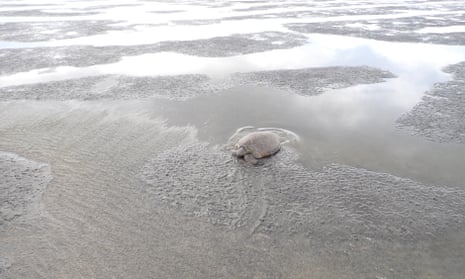Catastrophic floods earlier this year wiped out one of the largest and most important seagrass meadows in eastern Australia, increasing the risk that dugongs and sea turtles will become stranded, according to researchers.
Scientists from James Cook University monitored the health of seagrass meadows across 2,300 square kilometres of Hervey Bay and the Great Sandy Strait in southern Queensland.
Prof Michael Rasheed, who led the monitoring, said there has been a drastic loss compared with previous extensive mapping of seagrass cover.
“Our boat surveys show there’s almost no seagrass visible in the 2m to 17m depth range for much of the deeper meadows, and these sites have previously recorded extensive areas of seagrass,” he said. “There were some areas of sub-tidal seagrass but these were confined to the deepest areas in the northern part of the bay.

“We also used helicopters to assess more than 1,300 intertidal sites throughout the Great Sandy Straits and while some sites had seagrass the cover was typically less than one percent of the seafloor, offering scant resources for dugong and turtle.”
The decline in seagrass is due to sediment from floodwaters flowing into the ocean and reducing exposure to sunlight and smothering the seagrass. Dugongs and sea turtles rely on seagrass meadows for food.
Dr Chris Cleguer, a dugong expert, said there was concern that dugongs in the area may stop breeding.
“Some will move and some will die,” he said.
In 1991, the region lost more than 1,000 square kilometres of seagrass after subsequent and severe floods. It led to the highest rate of dugong deaths on record and a 20% decline in dugong calf numbers.
Cleguer said there had been an increase in turtle and dugongs becoming stranded in Queensland’s Great Sandy Marine Park over the past year. It suggested there may have been an unknown problem affecting the dugongs and sea turtles prior to the flooding.

Since July 2021, Queensland Parks and Wildlife Service have recorded more than 240 stranded marine turtles and 22 stranded dugongs in the park.
Parks senior ranger Dan Clifton said the numbers were significantly greater than the long-term average for the region.
“We have also recently seen large, mature green turtles presenting with an ulcerative skin disease affecting the carapace and flippers. This is currently being investigated by leading authorities to determine causes so we can respond accordingly,” Clifton said.
“The issues currently faced by marine wildlife in the Great Sandy Marine Park demonstrate the importance of ongoing research and surveys so that we can identify and respond to threats and how critical it is that we protect our precious ecosystems.”
Rasheed said it was difficult to know for certain whether seagrass decline was occurring prior to the flood events given there was no regular large-scale monitoring of seagrass meadows.
“It is highly likely though that what we’re seeing now is a result, at least in part or large part, due to the floods,” he said.
Rasheed said there was good news: seagrass meadows were about to enter their growing season. The scientists hope to monitor the meadows again in September and October to determine how much has recovered.
They say reports on the survey are expected to be released in June for Hervey Bay and September for the Great Sandy Straits.
